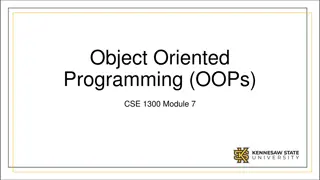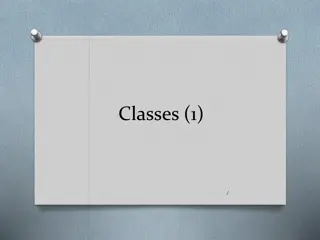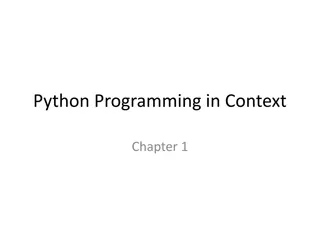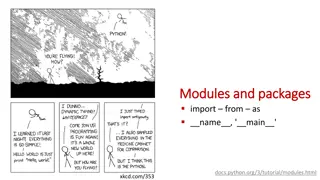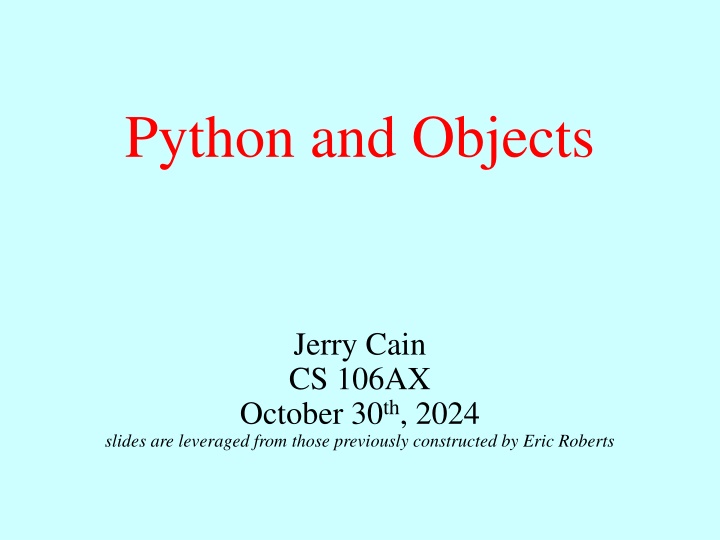
Understanding Python Objects and Classes in Programming
Explore the concepts of classes and objects in Python to represent data values, store attributes, and manipulate operations. Learn about aggregation, encapsulation, and inheritance in object-oriented programming. Discover how objects serve as collections of independent data values and how classes define structures and behaviors for values of a particular type.
Download Presentation

Please find below an Image/Link to download the presentation.
The content on the website is provided AS IS for your information and personal use only. It may not be sold, licensed, or shared on other websites without obtaining consent from the author. If you encounter any issues during the download, it is possible that the publisher has removed the file from their server.
You are allowed to download the files provided on this website for personal or commercial use, subject to the condition that they are used lawfully. All files are the property of their respective owners.
The content on the website is provided AS IS for your information and personal use only. It may not be sold, licensed, or shared on other websites without obtaining consent from the author.
E N D
Presentation Transcript
Python and Objects Jerry Cain CS 106AX October 30th, 2024 slides are leveraged from those previously constructed by Eric Roberts
Review: Classes and Objects While studying JavaScript, classes, and object orientation, we emphasized the distinction between classes and objects: A class is a pattern that defines the structure and behavior of values of a particular type. An object is a value that belongs to a class. A single class can be used to create any number of objects, each of which is an instance of that class. The JSGraphics library, for example, defines a GRectclass. In your Breakout assignment, you created many instances of the GRectclass one for each brick and one for the paddle each of which was a separate object.
Thinking About Objects GRect class location size color fill status fill color JSGraphics.js GRect GOval GLine GLabel ... I need a bunch of GRects. JSGraphics.js GRect GOval GLine GLabel ... client implementation abstraction boundary with thanks to Randall Monroe at xkcd.com
The Purposes of Objects Python uses the concepts of objects and classes to achieve at least three different goals: Aggregation. Objects make it possible to represent collections of independent data values as a single unit. In Python, such collections are traditionally called records. Encapsulation. Classes make it possible to store data values together with the operations that manipulate them. In Python, the data values are called attributes, and the operations are called methods. Inheritance. Class hierarchies make it possible for a class that shares some attributes and methods from a previously defined class to inherit those definitions without explicitly repeating the definitions. We won t speak about inheritance much more this quarter, but it s a hallmark feature of OOP and studied extensively in later courses.
Scrooge and Marley in Python While learning about aggregates during the JavaScript segment, we contrived a narrative about a tiny company employing Ebenezer Scrooge and Bob Cratchit. We ll revisit the example and work to promote our aggregates or records, as they re called in Python to classes. name name "Ebenezer Scrooge" "Bob Cratchit" title title "founder" "clerk" salary salary 1000 15
Classes as Templates The objects on the preceding slide are both instances of the same class, which for the moment means they share the same attributes. The class itself is visually defined by the template: name title salary Class definitions in Python, however, are sufficiently complex that it helps to start by using an empty template that creates blank-slate objects and then filling in the necessary fields.
Defining a Blank-Slate Class Class definitions in Python start with a header line consisting of the keyword class followed by the class name. Although the body of a class will later contain definitions of attributes and methods, it is possible to define a blank-slate version of the Employee class by leaving the body empty: class Employee: """This class has an empty body""" Python s syntactic rules do not allow an empty body. You can either use a docstring as in this example or the keyword pass. Once you have defined the Employee class, you can create an empty Employee object like this: clerk = Employee()
Object Values are References It is important to keep in mind that objects like all values in Python are stored as references. The blank-slate template created by the preceding slide therefore looks like this: clerk Any code that has access to this reference can manipulate the contents of the object. In particular, the reference allows code to get and set the contents of existing attributes or to create new ones.
Creating an Employee by Assignment clerk In Python, you can create a new attribute simply by assigning it a value, in much the same way that assigning a value to a variable creates a new local variable in the current frame. name "Bob Cratchit" title "clerk" salary 15
Constructors Although the strategy from the preceding slide creates an Employee object with the correct contents, making the client responsible for creating the attributes violates the spirit of object-oriented programming. The details of the data structure are the implementor's responsibility, not the client's. A better strategy for creating a new Employee object is to define a method called a constructor, which is responsible for initializing the attributes to the object. In Python, you define a constructor by implementing a special method called __init__, which is automatically called when a client uses the class name as a function. The first parameter to the __init__ method is called self and contains a reference to the new object. Any other arguments provided by the client are passed as additional parameters.
A Constructor for the Employee Class clerk salary 15 self name "Bob Cratchit" title "clerk" name "Bob Cratchit" title "clerk" salary 15
Defining Additional Methods In addition to the constructor, most classes define additional methods that allow clients to read or update attributes of the object or to manipulate the object in some way. Methods always declare an explicit parameter self at the beginning of the parameter list, just as the constructor does. A method definition therefore looks like this: def name(self,other parameters): . . . body of the method . . . Whenever the client calls a method on an object, Python initializes self to be a reference to the receiver, which is the object to which the method is applied.
Getters and Setters The simplest methods to describe are those that retrieve the value of an attribute, which are called getters, and those that set an attribute to a new value, which are called setters. The following definitions show the getter and setter for the salary attribute of an Employee object: def getSalary(self): return self.salary def setSalary(self, salary): self.salary = salary Getters are much more common than setters. You need to think carefully before providing a setter as to whether you want clients to be able to change the attribute.
Lists of Objects Because lists can contain values of any type, the elements of a list can be objects. For example, a list of the employees at Scrooge and Marley can be initialized like this: SCROOGE_AND_MARLEY = [ Employee("Ebenezer Scrooge", "founder", 1000), Employee("Bob Cratchit", "clerk", 15) ] The following function prints the payroll for the roster of employees supplied as an argument using our getter methods: def printPayroll(roster): for emp in roster: print(emp.getName() + " (" + emp.getTitle() + "): " + str(emp.getSalary()))
Converting Objects to Strings If for no other reason than that doing so simplifies debugging, it is good practice to include a __str__ method in each class to convert an object to a string. The __str__ method for the Employee class looks like this: def __str__(self): return self.name + " (" + self.title + "): " + str(self.salary) This definition allows you to simplify the printPayroll function to this much shorter form: def printPayroll(roster): for emp in roster: print(emp)







